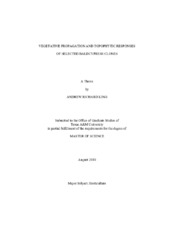| dc.description.abstract | Baldcypress, Taxodium distichum (L.) Rich., var. distichum is a highly adaptable
tree of significant ecological importance in the Southeastern U.S. Including Taxodium
distichum var. imbricarium (Pondcypress) and Taxodium distichum var. mexicanum
(Montezuma cypress), the native range is extended into south Texas and Mexico.
Previously, baldcypress selections were made for drought, foliar salt exposure and high
pH soil tolerance. Experiments were conducted beginning in May, 2008 to determine
commercial viability of vegetative propagation by shoot tip cuttings of these selections,
to identify treatment combinations that led to optimal rooted cutting quantity and quality,
and to determine whether baldcypress cuttings displayed a topophytic effect and if so, if
there was a correlation between branch angle on the ortet and topophysis exhibited by
ramets during nursery production. The propagation studies revealed that rooted cutting
quantity and quality were optimal when softwood cuttings were taken from south Texas
and/or Mexican provenances and treated with either 7,500 or 15,000 mg·L-1 K-IBA
(potassium salts of indole-3-butyric acid). A gradient was observed with cuttings from
more southern and western provenances typically exhibiting greater rooted cutting
quantity and quality than cuttings from more eastern and northern provenances. A tradeoff between greater rooting percentages in a substrate with greater aeration (100 percent
perlite) versus greater root quality (root numbers, length, or mass) in a substrate with a
higher water-holding capacity (100 percent peat moss) was also displayed. Additional basal
wounding proved to be detrimental to both rooted cutting quantity and quality. A
significant (P </= 0.05) topophytic effect was observed among genotypes for the divergence
of central leaders from a vertical orientation during nursery production, but the branch
angle of the cutting on the ortet was not a good predictor of this divergence on the ramet. | en |


